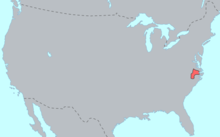Tuscarora (language)
| Tuscarora | |
|---|---|
| Ska:rù:rę' | |
| Native to | Canada, United States |
| Region | Six Nations of the Grand River First Nation in southern Ontario, Tuscarora Reservation in northwestern New York, and eastern North Carolina |
| Ethnicity | 1,200 Tuscarora people (1997) |
|
Native speakers
|
(9 cited 1991–2007) |
| Revival | none reported (2007) |
| Language codes | |
| ISO 639-3 | |
| Glottolog | tusc1257 |

Pre-contact distribution of Tuscarora
|
|
Tuscarora, sometimes called Skarò˙rə̨ˀ, is an Iroquoian language of the Tuscarora people, spoken in southern Ontario, Canada, North Carolina and northwestern New York around Niagara Falls, in the United States. The historic homeland of the Tuscarora was in eastern North Carolina, in and around the Goldsboro, Kinston, and Smithfield areas. Some Tuscaroras still live in this region, having migrated to present day Robeson County, NC. The name Tuscarora (/tʌskəˈrɔːrə/ tus-kə-ROR-ə) means "hemp people," after the Indian hemp or milkweed which they use in many aspects of their society. Skarureh refers to the long shirt worn as part of the men's regalia, hence "long shirt people".
Tuscarora is a severely endangered language. As of the mid-1970s, only about 52 people spoke the language on the Tuscarora Reservation (Lewiston, New York) and the Six Nations of the Grand River First Nation (near Brantford, Ontario). The Tuscarora School in Lewiston has strived to keep the language alive, teaching children from pre-kindergarten to sixth grade. However, the only native speakers are older adults.
...
Wikipedia
